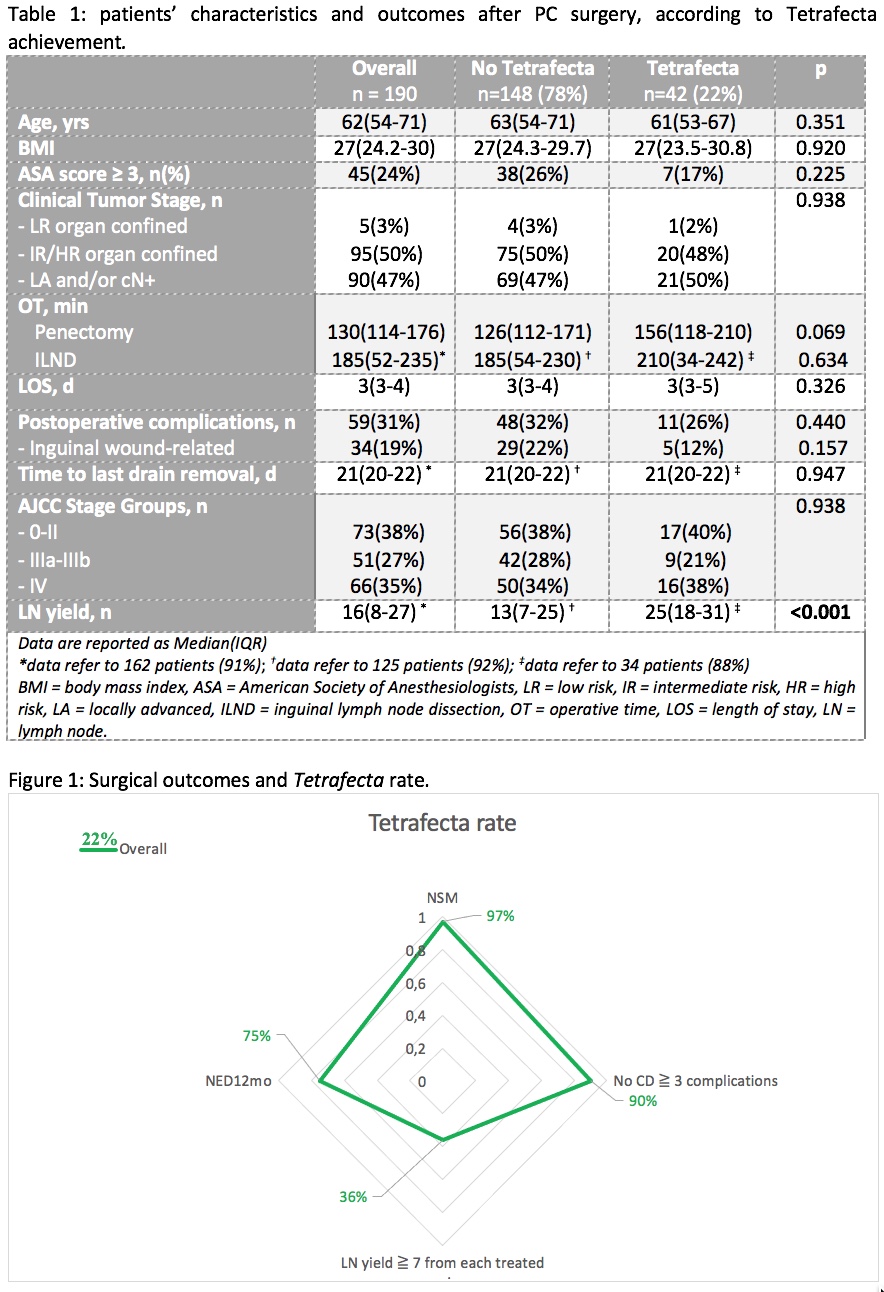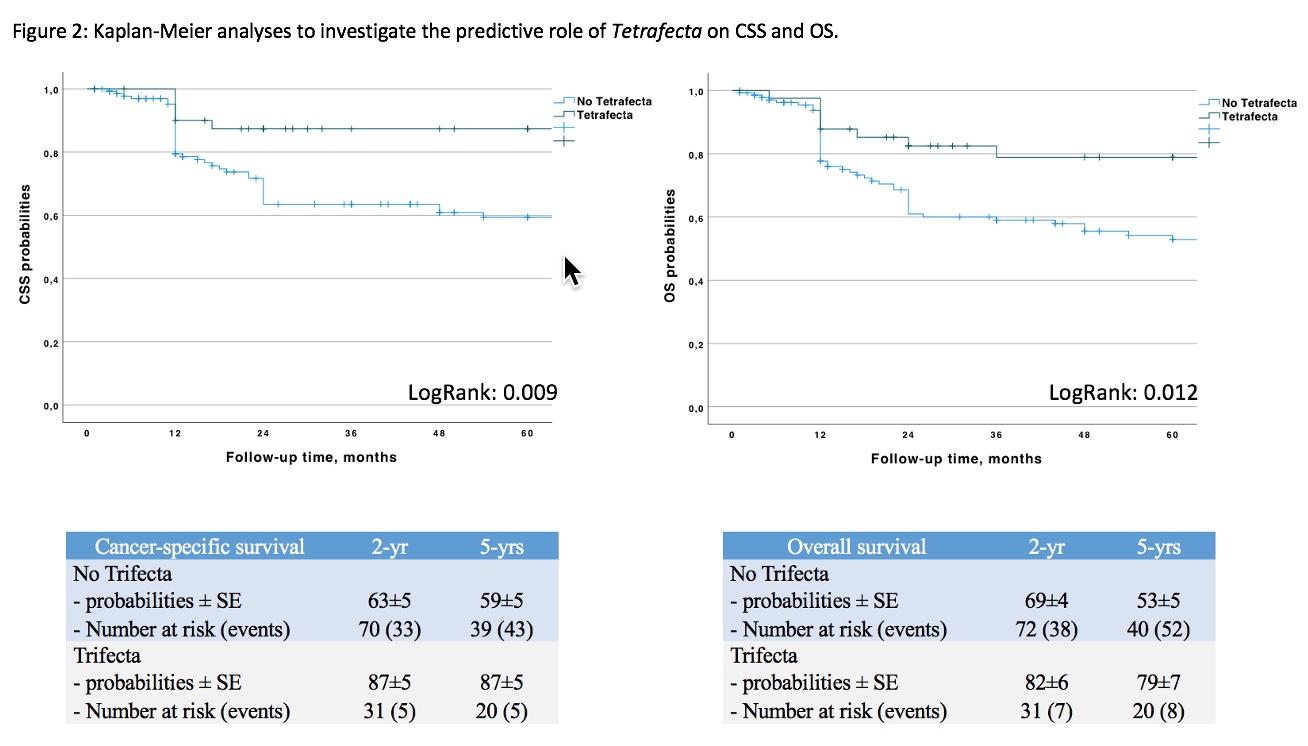Back
Poster, Podium & Video Sessions
Moderated Poster
MP46: Penile & Testicular Cancer I
MP46-19: Combined reporting of surgical quality and cancer control after surgical treatment for penile tumors: the Tetrafecta achievement
Sunday, May 15, 2022
1:00 PM – 2:15 PM
Location: Room 222
Aldo Brassetti*, Alfredo Bove, Umberto Anceschi, Maria Consiglia Ferriero, Salvatore Guaglianone, Riccardo Mastroianni, Leonardo Misuraca, Gabriele Tuderti, Rome, Italy, Gabriele Cozzi, Milan, Italy, Pavel Gavrilov, Barcelona, Spain, Julian Andres Chavarriaga, Bogota, Colombia, Gennaro Musi, Ottavio de Cobelli, Milan, Italy, Alberto Breda, Josep Maria Gaya Sopena, Barcelona, Spain, Diego Camacho, Rodolfo Varela, Bogota, Colombia, Giuseppe Simone, Rome, Italy
- AB
Poster Presenter(s)
Introduction: Different combined outcomes have been proposed to optimize results reporting after urologic cancer surgery but none for penile tumors. We proposed a Tetrafecta and assessed its ability to predict cancer-specific (CSS) and overall survival (OS) probabilities.
Methods: a purpose-built multicenter database was queried for patients with non-metastatic penile cancer (PC) who underwent total/partial penectomy ± inguinal lymph node dissection (ILND) at the 3 participating institutions from 2015 onwards. Baseline demographic, clinical, pathologic and perioperative data were collected. Tetrafecta was defined endorsing standardized and reproducible variables: negative surgical margins (NSM), no severe complications (Clavien Dindo grade =3), = 7 lymph nodes (LNs) retrieved from each treated groin (when ILND was due), no evidence of disease at 12 months (NED12mo). The study population was split according to Tetrafecta achievement: ?²- and Kruskal-Wallis tests were used to compare categorical and continuous variables. Kaplan-Meier analysis was performed to investigate the predictive role of Tetrafecta on CSS and OS.
Results: overall, 276 patients were collected but 98 were excluded from the analysis because of missing data. Out of 178 included PC-men, 42 (24%) achieved the Tetrafecta (Tab 1) (Fig 1). The 2 groups showed comparable baseline characteristics (all p>0.05). On Kaplan-Meier analysis, the Tetrafecta cohort displayed significantly higher CSS (p=0.009) and OS (p=0.014) probabilities (Fig 2).
Conclusions: our Tetrafecta is the first combined outcome to comprehensively report perioperative outcomes after surgery for PC. It is widely applicable, based on standardized and reproducible variables and it predicts cancer-specific and all-cause mortality.
Source of Funding: none


Methods: a purpose-built multicenter database was queried for patients with non-metastatic penile cancer (PC) who underwent total/partial penectomy ± inguinal lymph node dissection (ILND) at the 3 participating institutions from 2015 onwards. Baseline demographic, clinical, pathologic and perioperative data were collected. Tetrafecta was defined endorsing standardized and reproducible variables: negative surgical margins (NSM), no severe complications (Clavien Dindo grade =3), = 7 lymph nodes (LNs) retrieved from each treated groin (when ILND was due), no evidence of disease at 12 months (NED12mo). The study population was split according to Tetrafecta achievement: ?²- and Kruskal-Wallis tests were used to compare categorical and continuous variables. Kaplan-Meier analysis was performed to investigate the predictive role of Tetrafecta on CSS and OS.
Results: overall, 276 patients were collected but 98 were excluded from the analysis because of missing data. Out of 178 included PC-men, 42 (24%) achieved the Tetrafecta (Tab 1) (Fig 1). The 2 groups showed comparable baseline characteristics (all p>0.05). On Kaplan-Meier analysis, the Tetrafecta cohort displayed significantly higher CSS (p=0.009) and OS (p=0.014) probabilities (Fig 2).
Conclusions: our Tetrafecta is the first combined outcome to comprehensively report perioperative outcomes after surgery for PC. It is widely applicable, based on standardized and reproducible variables and it predicts cancer-specific and all-cause mortality.
Source of Funding: none



.jpg)
.jpg)